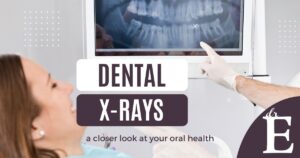Dental X-Rays
A Closer Look at Your Oral Health
Dental X-rays are more than just a routine part of your visit to the dentist—they’re a key tool for maintaining your oral health and catching potential issues early. In this post, we’ll explore why dental X-rays are important, the differences between panoramic and digital X-rays, the safety advancements in X-ray technology, and how this essential tool has evolved over time.
Why Are Dental X-Rays Important?
While a visual exam can reveal a lot about the health of your teeth and gums, there are many things your dentist can’t see with the naked eye. Dental X-rays allow us to detect problems such as:
- Cavities between teeth
- Infections in the bone or abscesses
- Gum disease affecting the bone
- Impacted teeth
- Developmental issues in children and teens
- Signs of oral cancer
Early detection means we can address these issues before they become bigger problems, saving you time, discomfort, and money.
Panoramic vs. Digital X-Rays
There are two common types of dental X-rays: panoramic and digital.
- Panoramic X-Rays
These provide a broad view of your entire mouth, including your teeth, jaws, and sinuses. They’re especially useful for diagnosing problems with wisdom teeth, jaw alignment, and sinus issues. - Digital X-Rays
Digital X-rays are more detailed and focus on specific areas of your mouth. They’re great for identifying small cavities, monitoring existing dental work, and keeping an ongoing record of your dental health.
Digital X-rays also have the added advantage of being more efficient and environmentally friendly since they don’t require film processing.
Safety First: Are Dental X-Rays Safe?
We understand that some patients may feel concerned about radiation exposure, but modern dental X-rays are extremely safe. Here’s why:
- Low Radiation: Advances in technology mean dental X-rays now use minimal radiation, significantly lower than what you’d encounter during a flight.
- Targeted Imaging: Modern equipment focuses X-rays directly on the area being examined, reducing unnecessary exposure.
- Protective Gear: Patients wear lead aprons and thyroid collars to shield their bodies from radiation.
Your safety is our priority, and we only recommend X-rays when they’re necessary for your care.
How X-Ray Technology Has Evolved
Dental X-rays have come a long way since their introduction in the late 19th century. Today’s advancements include:
- Digital Imaging: Faster, clearer images that can be enhanced for better diagnostics.
- 3D Imaging: Newer tools like cone-beam CT scans provide detailed, three-dimensional views of your teeth and jaw.
- Reduced Radiation: Today’s machines emit significantly less radiation compared to older models.
These advancements allow us to provide more accurate diagnoses, better treatment planning, and a safer experience for you.
When Should You Have Dental X-Rays?
The frequency of dental X-rays depends on your individual needs, oral health history, and current dental concerns. For most patients, X-rays are recommended every 1-2 years. However, children, teens, or those with ongoing dental issues may need them more often.
Take the Next Step for Your Oral Health
At Dr. E’s Cosmetic & Family Dentistry, we’re committed to providing you with the best care using the latest technology. Dental X-rays are just one of the tools we use to ensure your smile stays healthy and beautiful for years to come.
Ready to schedule your next checkup? Call or text us today at 📞 480-494-2435!
Contact us for comments or questions: https://drefamilydental.com/contacts/


